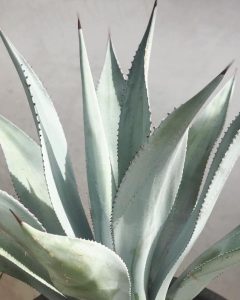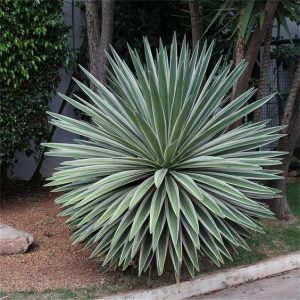Agave is an old and unique plant with persistent vitality and a breathtaking florescence. Having existed for sixty million years, the agave plant is not only very beautiful but also has a lot of cultural and historical connotations.

Agave detail
The History of Agave: Origins
About sixty million years ago, the history of agave might have started with the first world’s creation. This plant had already begun to thrive in the relatively ancient geological era during that historical time. Originally native to tropical America, especially in dry and semi-arid areas of Mexico, the southern portion of the United States, and Central America, agave is a plant Agave, a member of the genus Agave and belonging to the family Asparagaceae, has gradually evolved its unique growth patterns and leaves over its evolutionary background.
Attributes exclusive to agave
Leaf characteristics
The Agave plant’s leaves are strong and rather beautiful. Their dark brown spiked stiffness at the tip shapes them like a succulent rosette. Furthermore, the leaf margins include small thorns-like teeth. Agave’s wild character comes from these elements, which also give it a somewhat unique appearance. As the plant ages, the crown breadth of the leaves increases steadily, producing an even more breathtaking visual impact.
The characteristics of the flossom
With the record for the highest inflorescence ever recorded reaching 3.9 meters, the Agave plant has a really big and striking display. The flower stem is strong and creates a large panicle while the bloom is in progress. It also has a huge count of flowers and is very beautiful. Though every Agave blossoms differently, its tall and breathtaking inflorescences help them to draw people in.
Against drought and with regard to adaptation
Agave has great endurance for both drought and extreme heat and may flourish on nutrient-starved soils. Since they reach far down, their roots may effectively draw water from the ground. Usually growing slowly, agave takes seven to fourteen years to reach harvesting phase. Its life span might run eight to forty years.
Agave has medicinal value.
Agave has a unique value in terms of decoration as well as some medicinal use. Among the most often used treatments for this substance—which has a taste characterized as warm, sour, and bitter respectively—detoxification, pus extraction, insecticide, and hemostasis. Among the disorders treated with agave in traditional medicine are carbuncle, scabies, pelvic inflammatory disease, uterine bleeding, stubborn ulcers, and plantar abscesses. Plantar abscesses are among them. These medicinal properties help agave to be very important in the realm of traditional medicine.
Agave is an important commercial good as well as a cultural symbol.
Generation of tequila
The main raw source utilized in the manufacturing of tequila is the plentiful sugar-containing agave plant stems. One kind of wine made in Mexico that is especially well-known for its distinctive taste and smoothness is tequila. Beginning with the harvesting and processing of agave and working through fermentation and distillation, every step of the brewing process requires great attention. Every step in the chain carries Mexican brewing history and culture.
The emblem of civilization
Agave is, most people agree, the “national plant” of Mexico. Furthermore deeply embedded in Mexico’s history and culture is it, which represents the pride Mexicans have for their nation. Apart from its great reputation in China, tequila, the national wine of Mexico, shows to the rest of the globe the unique style and appeal Mexico is renowned for.
Uses of agave and plant cultivation
The terms of farming
Agave may be cultivated well in dry conditions, hence it is advised to utilize sandy soil with proper drainage in farming. Agave has been imported and cultivated in many provinces and areas in southern and southwestern China, especially in Yunnan, the place where it may bloom to realize its full potential and provide fruit. Since these dry, hot valleys provide ideal growth conditions, the environment of agave is perfect for development.
Ornamental details and applied work
Agave is a common attractive plant in gardens because of its height of inflorescence and unique curvature of leaves. Agave may show its interesting and unique characteristics whether it is used as a potted ornamental plant or as a pattern of green spaces like parks, flower gardens, or lawns. This plant is a great option for cosmetic reasons in many different environments because its robust leaves tolerate drought.
Agave’s consumable and other uses
Historical accounts of Central America indicate that agave has been used there for thousands of years. Traditionally, people have ate the soft, white meristem found at the agave plant’s stem or base. Starch abound in this meristem. Two other ways to enjoy agave are baking and cooking. People living in the northern part of Mexico also feed animals agave leaves. Agave’s versatility makes it more important in modern usage as well as in traditional ones.

Agave plant
With its lengthy history, unique characteristics, and great cultural significance, agave—a plant sixty million years old—has become a major player in both ornamental plants and commercial crops. In many different spheres, including its medicinal value, economic contribution, and impact on cultural imagery, agave has shown its indispensible relevance. At the same time as it is a plant with historical and modern relevance, it is also a green gem beloved all around. Once we understand the history and usage of agave, we will be more suited to value and protect this unique plant.




